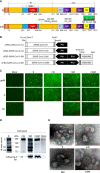Immunogenicity and protective potential of chimeric virus-like particles containing SARS-CoV-2 spike and H5N1 matrix 1 proteins
- PMID: 35923799
- PMCID: PMC9339902
- DOI: 10.3389/fcimb.2022.967493
Immunogenicity and protective potential of chimeric virus-like particles containing SARS-CoV-2 spike and H5N1 matrix 1 proteins
Abstract
Coronavirus Disease 2019 (COVID-19), caused by severe acute respiratory syndrome coronavirus type 2 (SARS-CoV-2), has posed a constant threat to human beings and the world economy for more than two years. Vaccination is the first choice to control and prevent the pandemic. However, an effective SARS-CoV-2 vaccine against the virus infection is still needed. This study designed and prepared four kinds of virus-like particles (VLPs) using an insect expression system. Two constructs encoded wild-type SARS-CoV-2 spike (S) fused with or without H5N1 matrix 1 (M1) (S and SM). The other two constructs contained a codon-optimized spike gene and/or M1 gene (mS and mSM) based on protein expression, stability, and ADE avoidance. The results showed that the VLP-based vaccine could induce high SARS-CoV-2 specific antibodies in mice, including specific IgG, IgG1, and IgG2a. Moreover, the mSM group has the most robust ability to stimulate humoral immunity and cellular immunity than the other VLPs, suggesting the mSM is the best immunogen. Further studies showed that the mSM combined with Al/CpG adjuvant could stimulate animals to produce sustained high-level antibodies and establish an effective protective barrier to protect mice from challenges with mouse-adapted strain. The vaccine based on mSM and Al/CpG adjuvant is a promising candidate vaccine to prevent the COVID-19 pandemic.
Keywords: Coronavirus Disease 2019 (COVID-19); chimeric; severe acute respiratory syndrome coronavirus type 2 (SARS-CoV-2); spike; virus-like particle (VLP).
Copyright © 2022 Chen, Xu, Li, Yi, Jiang, Hao, Xu, Zou, Li, Gao, Tian, Jin, Ren and Li.
Conflict of interest statement
The authors declare that the research was conducted in the absence of any commercial or financial relationships that could be construed as a potential conflict of interest.
Figures





Similar articles
-
Construction and immunogenicity of SARS-CoV-2 virus-like particle expressed by recombinant baculovirus BacMam.Microbiol Spectr. 2024 Aug 6;12(8):e0095924. doi: 10.1128/spectrum.00959-24. Epub 2024 Jun 25. Microbiol Spectr. 2024. PMID: 38916311 Free PMC article.
-
Chimeric severe acute respiratory syndrome coronavirus (SARS-CoV) S glycoprotein and influenza matrix 1 efficiently form virus-like particles (VLPs) that protect mice against challenge with SARS-CoV.Vaccine. 2011 Sep 2;29(38):6606-13. doi: 10.1016/j.vaccine.2011.06.111. Epub 2011 Jul 14. Vaccine. 2011. PMID: 21762752 Free PMC article.
-
Development and Evaluation of a Newcastle Disease Virus-like Particle Vaccine Expressing SARS-CoV-2 Spike Protein with Protease-Resistant and Stability-Enhanced Modifications.Viruses. 2024 Dec 18;16(12):1932. doi: 10.3390/v16121932. Viruses. 2024. PMID: 39772238 Free PMC article.
-
Tapping the immunological imprints to design chimeric SARS-CoV-2 vaccine for elderly population.Int Rev Immunol. 2022;41(4):448-463. doi: 10.1080/08830185.2021.1925267. Epub 2021 May 12. Int Rev Immunol. 2022. PMID: 33978550 Free PMC article. Review.
-
A perspective on SARS-CoV-2 virus-like particles vaccines.Int Immunopharmacol. 2023 Feb;115:109650. doi: 10.1016/j.intimp.2022.109650. Epub 2023 Jan 11. Int Immunopharmacol. 2023. PMID: 36649673 Free PMC article. Review.
Cited by
-
1Progress, applications, challenges and prospects of protein purification technology.Front Bioeng Biotechnol. 2022 Dec 6;10:1028691. doi: 10.3389/fbioe.2022.1028691. eCollection 2022. Front Bioeng Biotechnol. 2022. PMID: 36561042 Free PMC article. Review.
-
Respiratory Viruses and Virus-like Particle Vaccine Development: How Far Have We Advanced?Viruses. 2023 Jan 30;15(2):392. doi: 10.3390/v15020392. Viruses. 2023. PMID: 36851606 Free PMC article. Review.
-
Antibiotics daptomycin interacts with S protein of SARS-CoV-2 to promote cell invasion of Omicron (B1.1.529) pseudovirus.Virulence. 2024 Dec;15(1):2339703. doi: 10.1080/21505594.2024.2339703. Epub 2024 Apr 24. Virulence. 2024. PMID: 38576396 Free PMC article.
-
The Papain-like Protease Domain of Severe Acute Respiratory Syndrome Coronavirus 2 Conjugated with Human Beta-Defensin 2 and Co1 Induces Mucosal and Systemic Immune Responses against the Virus.Vaccines (Basel). 2024 Apr 19;12(4):441. doi: 10.3390/vaccines12040441. Vaccines (Basel). 2024. PMID: 38675823 Free PMC article.
-
A Vaccine of SARS-CoV-2 S Protein RBD Induces Protective Immunity.Int J Mol Sci. 2022 Nov 8;23(22):13716. doi: 10.3390/ijms232213716. Int J Mol Sci. 2022. PMID: 36430190 Free PMC article.
References
-
- Bright R. A., Carter D. M., Crevar C. J., Toapanta F. R., Steckbeck J. D., Cole K. S., et al. . (2008). Cross-clade protective immune responses to influenza viruses with H5N1 HA and NA elicited by an influenza virus-like particle. PLoS One 3, e1501. doi: 10.1371/journal.pone.0001501 - DOI - PMC - PubMed
-
- Bright R. A., Carter D. M., Daniluk S., Toapanta F. R., Ahmad A., Gavrilov V., et al. . (2007). Influenza virus-like particles elicit broader immune responses than whole virion inactivated influenza virus or recombinant hemagglutinin. Vaccine 25, 3871–3878. doi: 10.1016/j.vaccine.2007.01.106 - DOI - PubMed
Publication types
MeSH terms
Substances
LinkOut - more resources
Full Text Sources
Medical
Miscellaneous

